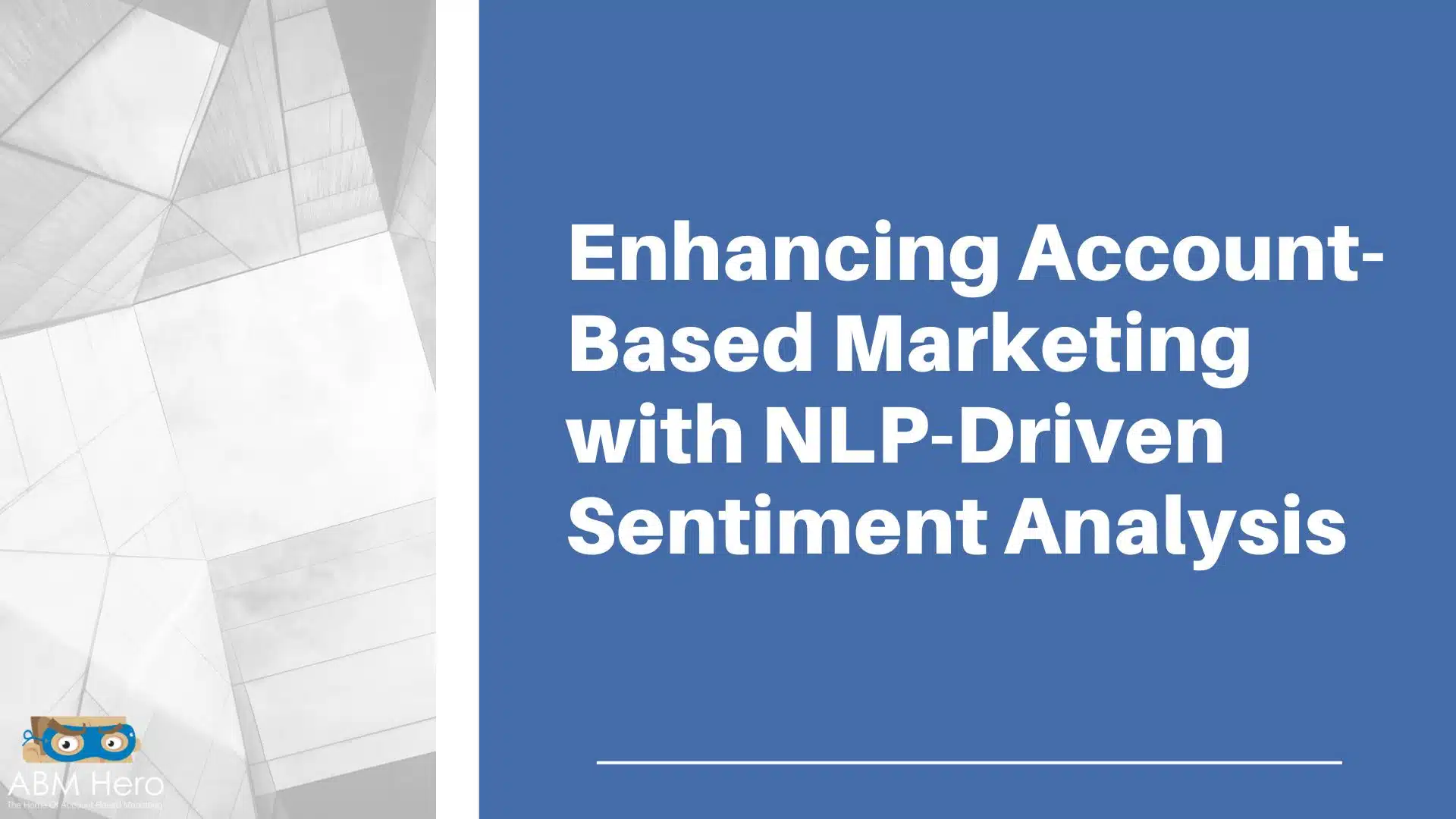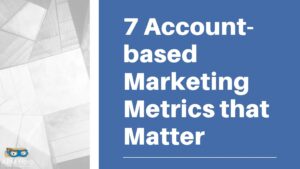In the era of data-driven decision-making, B2B companies have been increasingly adopting Account-Based Marketing (ABM) strategies to target and engage with specific accounts.
ABM allows businesses to create personalized experiences, build stronger relationships, and drive growth.
However, to optimize ABM campaigns and deliver highly tailored content, B2B companies need to understand the sentiments of their target accounts.
This is where Natural Language Processing (NLP)-driven Sentiment Analysis comes into play.
This article will uncover how NLP-driven Sentiment Analysis changes the game for most companies using ABM strategies.
What is Sentiment Analysis?
Sentiment Analysis, also known as opinion mining, is a process that involves analyzing textual data to determine the sentiment expressed within it.
Using NLP techniques, sentiment analysis algorithms can identify and interpret emotions, attitudes, and opinions within written content, such as social media posts, online reviews, and customer feedback.
NLP, or Natural Language Processing, is a cutting-edge technology that enables us to understand and analyze the language used by our customers in their interactions with our brand.
We can extract valuable emotional cues from their messages, reviews, and social media posts with sentiment analysis.
This analysis goes beyond simply understanding what customers are saying; it allows us to grasp the underlying emotions behind their words.
We can determine if they are happy, satisfied, disappointed, or even frustrated with our offerings.
This information is precious as it gives us a clear picture of their sentiments towards our brand.
Benefits of Sentiment Analysis in ABM
Implementing sentiment analysis in ABM strategies can provide several advantages for B2B companies. Here are some of them:
Enhanced Personalization
Personalizing messages in B2B marketing goes beyond simply using the recipient’s name.
By analyzing the sentiments of targeted accounts, businesses gain insights into their prospects’ specific emotions, needs, and pain points.
When a B2B company aims to personalize its message, they consider specific information about its target clients, such as their industry, role, pain points, and interests.
For example, in email marketing campaigns, the company will segment its audience based on relevant criteria instead of sending generic messages to an extensive list of recipients.
They can group clients from the same industry or similar job roles into specific segments. Then, they craft customized email content that directly addresses each segment’s unique challenges and needs.
In the personalized emails, they may refer to the client’s industry, acknowledge their role and responsibilities, and provide solutions that align with their pain points.
By doing so, the company shows that they understand the client’s needs, making the message more relevant and compelling.
Personalization in B2B marketing helps build stronger connections with clients, demonstrating that the company values its unique requirements.
This approach can lead to higher engagement rates, improved customer loyalty, and ultimately, increased success in converting leads into long-term customers.
Early Detection of Issues
Monitoring sentiment analysis in real-time enables B2B companies to promptly identify any negative sentiments expressed by their target accounts.
Early detection of issues or dissatisfaction allows immediate action, such as reaching out to those accounts and addressing concerns, thereby maintaining a positive brand image. Here’s an example:
A B2B software company uses NLP-driven sentiment analysis to assess customer feedback and support tickets for their new software release.
As various clients use the software, the company continuously collects and analyzes customer messages, emails, and social media interactions related to the new product.
The company identifies a growing number of negative sentiments and customer complaints about a specific feature in the software through sentiment analysis.
These negative sentiments are not yet widespread, but the NLP-driven analysis detects a pattern indicating potential issues.
With this early warning, the company’s customer support team immediately addresses the emerging problem.
They proactively reach out to the affected customers to understand their concerns better and provide timely solutions or workarounds.
The development team is also informed of the sentiment analysis results, allowing them to start working on a quick fix for the feature in question.
As a result, the company effectively prevents the issue from escalating and impacting a more extensive customer base. They demonstrate their commitment to customer satisfaction by addressing the problem swiftly, fostering customer loyalty and goodwill.
By leveraging NLP-driven sentiment analysis, the B2B software company gains valuable insights into customer sentiments at an early stage.
This enables them to detect potential issues before they become widespread, allowing for proactive measures to maintain a positive customer experience and preserve the company’s reputation.
Competitive Analysis
Sentiment analysis can also help B2B companies gain a competitive edge by evaluating sentiments toward their competitors.
This data can be utilized to understand the strengths and weaknesses of competing businesses, helping to refine marketing strategies, improve products or services, and differentiate from the competition.
NLP-driven sentiment analysis can be a powerful tool for companies to assess the competition in their chosen market by providing valuable insights into how customers and the general public perceive competitors.
Here are some ways in which NLP-driven sentiment analysis can assist in competition assessment:
Social Media Monitoring
NLP-driven sentiment analysis can track and analyze social media conversations, comments, and posts about competitors.
By gauging the sentiment behind these interactions, companies can understand how customers feel about their rivals’ products, services, and brand reputation.
Online Reviews and Customer Feedback
NLP can process and analyze online reviews and customer feedback related to competitors.
This helps companies identify the strengths and weaknesses of competing products or services and understand what customers like or dislike about their rivals.
News and Media Analysis
NLP-driven sentiment analysis can be used to monitor news articles and media coverage about competitors.
Companies can identify trends, track changes in public perception, and assess the impact of events or announcements on competitor sentiment.
Product Comparisons
NLP can be used to analyze product comparisons and customer discussions about competitors’ offerings.
This helps companies understand how their products stack up against the competition and identify areas for improvement or differentiation.
Customer Satisfaction Measurement
Sentiment analysis tools can automatically analyze customer feedback and reviews, thereby quantifying customer satisfaction or dissatisfaction.
This data can track improvements or regressions in customer sentiment over time, enabling B2B companies to enhance their offerings and address any negative sentiment trends continually.
NLP-aided sentiment analysis can significantly contribute to Customer Satisfaction Measurement by better understanding customer sentiments and feedback. Here’s how it achieves this:
Comprehensive Feedback Analysis
NLP-driven sentiment analysis can quickly and efficiently process a large volume of customer feedback, including surveys, reviews, emails, and social media comments.
It categorizes sentiments as positive, negative, or neutral, giving companies a holistic view of customer satisfaction.
Real-Time Feedback Monitoring
With NLP, companies can monitor customer sentiments in real-time.
This enables prompt responses to emerging issues or concerns, ensuring that customer satisfaction is continuously assessed and improved.
Identifying Pain Points
NLP-aided sentiment analysis helps identify specific pain points and areas of dissatisfaction experienced by customers.
By pinpointing these pain points, companies can take targeted actions to address them, improving customer satisfaction.
Comparing Customer Satisfaction Across Time
Companies can use NLP-driven sentiment analysis to track changes in customer sentiment over time.
This allows them to measure the impact of product updates, marketing campaigns, or customer service improvements on customer satisfaction levels.
Implementing NLP-Driven Sentiment Analysis
To effectively integrate sentiment analysis into ABM campaigns, B2B companies can follow these steps:
Data Collection
Collect relevant textual data from various customer touchpoints, such as social media platforms, online reviews, surveys, and customer support interactions.
The larger the dataset, the more accurate the sentiment analysis results.
Preprocessing and Feature Extraction
Clean and organize the collected data by removing irrelevant information, such as stop words and punctuation, and transforming it into a structured format suitable for sentiment analysis.
Extract relevant features, such as keywords and phrases, to enhance the accuracy of sentiment analysis models.
Training Sentiment Analysis Models
Use machine learning algorithms to train sentiment analysis models.
These models can be trained using labeled datasets where sentiments are manually assigned to each document.
Continuous model refinement and validation are crucial to ensure accuracy.
Real-time Sentiment Analysis
Integrate sentiment analysis models into ABM platforms to analyze the sentiments of targeted accounts in real time.
This integration allows businesses to monitor sentiment trends, identify potential issues, and personalize marketing efforts based on sentiment insights.
In the quest to provide personalized and impactful experiences for their target accounts, B2B companies find immense value in NLP-driven sentiment analysis, which enhances their Account-Based Marketing (ABM) strategies.
By harnessing sentiment analysis, businesses gain crucial insights into prospects’ emotions, needs, and preferences, enabling them to deliver tailored content and foster strong customer relationships.
As NLP technologies advance, sentiment analysis will remain a key driver in optimizing ABM campaigns and propelling business growth.





